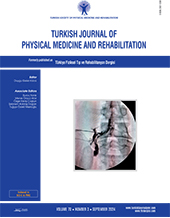Does transforaminal epidural steroid injection added to dorsal root ganglion pulsed radiofrequency treatment increase efficacy?
2 Department of Algology, Dr. Abdurrahman Yurtaslan Oncology Training and Research Hospital, Ankara, Türkiye
3 Department of Algology, Ankara Bilkent City Hospital, Ankara, Türkiye
4 Department of Algology, Adıyaman University Training and Research Hospital, Adıyaman, Türkiye DOI : 10.5606/tftrd.2024.13479 Objectives: This study aimed to compare the treatment outcomes between dorsal root ganglion (DRG) pulsed radiofrequency (PRF) and DRG PRF plus transforaminal epidural steroid injection (TFESI) in patients with chronic lumbosacral radicular pain.
Patients and methods: Eighty-one patients (39 males, 42 females; mean age: 57.5±11.9 years; range 18 to 65 years) who underwent DRG PRF (Group 1) and 59 patients (34 males, 25 females; mean age: 58.7±12.3 years; range 18 to 65 years) who underwent DRG PRF plus TFESI (Group 2) between February 2021 and June 2022 were enrolled in the retrospective study. A Visual Analog Scale (VAS) was used to assess pain severity. Patients in both groups were evaluated before treatment and at four weeks and six months after treatment.
Results: The four-week and six-month VAS scores were significantly lower than the baseline VAS scores in both groups. There was no significant difference between the groups in terms of the VAS scores at baseline, four weeks, and six months. There was no significant difference between the groups in terms of the rate of pain reduction of 50% or more at either measurement point. The presence or absence of a previous lumbar surgery had no effect on achieving a significant decrease in pain.
Conclusion: Although DRG PRF and TFESI are easy to apply together, adding corticosteroids to DRG PRF treatment for patients with chronic radicular pain did not improve long-term outcomes.
Keywords : Fluoroscopy, intervertebral disc, neuropathic pain, postlaminectomy syndrome, pulsed radiofrequency treatment, steroids

















